The Cultural Void That Is The Front Range Of Colorado
It doesn't have to be this way, Colorado!
There’s a loneliness, a sadness, even a visceral discomfort that I feel every time I’m back in my home state of Colorado. I used to pin this on Colorado Springs, the city I was raised in. And for good reason. Despite the outdoor access, it is a bleak, right-wing, military-heavy, opioid and meth overwhelmed, evangelical haven of a city. It is home to mega churches, fundamentalist groups like Focus on the Family, and it’s where the Libertarian party was officially founded. It’s a place where adults race Hondas on the avenue and protest outside Planned Parenthood as a pastime. It is a cultural void.
I’ve visited Colorado several times since moving out two decades ago, back for weddings and visits with friends. Each return I earnestly believe I will love my home state, that my view is tainted by a past life, and my fresh eyes will shine a new light on it. But during these return trips, I inevitably end up stuck somewhere in the Front Range with the same dissapointment. Colorado Springs may have been what I actively hated while growing up, and it still gives me the worst of my unsettling feelings, but Denver, which has a reputation as a top city to visit and move to, has a palpable soullessness too.
What few people understand about Colorado, or no one wants to say out loud, is that half of Colorado is ugly (cue Dumb & Dumber). The Eastern side is just a bad version of Kansas farmland – the dry high plains, a sea of tall yellow prairie grass bleeding into a dusty, washed out horizon that never ends. The Western half is the Rocky Mountain expectation of Colorado – an epic panorama of inspiration – dark green national forests giving way to craggy peaks, some snow-covered year round. And the Front Range, home to the Springs and Denver, well, it sits right between these two worlds.
In fact, Colorado’s 17 largest cities by population (several are just sprawling suburbs around Denver), dot the Front Range. Many of these cities lie in the flatlands and gaze through miles of chalky haze to the edge of the western ideal. If you’re visiting Colorado, and you’re not making your way into the mountains, say, hitting a requisite bougie ski town, you’re likely living in the limbo of the Front Range.
But here’s the thing, I can handle ugly, and many parts of Colorado Springs aren’t. If there’s a single distinguishing factor between it and Denver (excluding population size and all that comes with it) it’s that the Springs delivers on the promise of the mountains where Denver falls short. Much of the Springs is in the foothills! I grew up just a 5-minute drive from the dozens of trails in beautiful Cheyenne Canyon, 15 minutes from Garden of the Gods, and 15 minutes from the Manitou Incline and Barr Trail, the route up Pikes Peak. And yet I feel empty when I’m there.
If you end up in Colorado Springs, you’ll know why. Even if you like hiking & trail running or road & mountain biking, you’ll be planning your exit strategy. The mountains are in fact, right there, and the Olympic Training Center is too, making you think it will be an outpost for athletic adventure seekers. But the predominance of evangelical Christians, a heavy military presence, a forgotten lower class, and a generally closed off conservatism in the community stunts much opportunity at cultural growth and a stoked vibe. Couple that with an urban sprawl so vast that it feels like the city was developed with the intention of dissolving any community engagement. The expansive square mileage afforded to what is in fact a modest population of 480,000 makes it a car-first city with few neighborhood spots to congregate.
You’re either in a residential-only area or a strip mall. There are few neighborhoods that have easy walking access to a coffee shop, a restaurant, or neighborhood bar, let alone any access to daily essentials to complete an errand on foot (downtown is the sole exception). Sidewalks exist, but this city rails against pedestrians. Most everything requires getting in the car and landing at a benign, at best, shopping plaza.
But even that flawed experience is surmountable if the destination is unique and inviting. But too often they’re not. A city like Tucson, for example, is also a mid-sized sprawling city, but the outposts requiring a car thrive and are authentic to Tucson. You’re getting something real – owners have pride in their city and want to honor what makes it unique – be it celebrating some of the best Mexican food in the country, great winter weather, or glorifying the Saguaro Desert. And the patrons want to partake and revel in it. In the Springs that same drive regularly ends at a chain store, fast food spot, or another version of a place that could be anywhere.
Did this city get so unwelcoming because of the people it attracted, or did the lack of excitement and engagement trample the population into a pile of indifference? Probably a bit of both. The general feeling I get from the residents in my hometown is that they’re not particularly energized about their city or their prospects in it.
The city feels disemboweled of community to the point that I get depressed when I’m there and feel alone even when I’m not. Bless the businesses that have found a niche and are chipping away at the guarded walls of this society and building rapport with their neighbors, but it feels like an impossible task when the city continues to spread outward, further loosening the threads of connection. The pervasive conservatism and the America dream to have a driveway and a lawn may be too great for a handful of small business owners to direct meaningful change. In some ways, it feels like the Springs is mimicking the worst parts of big brother Denver, a city that promises the best of both worlds, where mountains meet the bustling city, but in reality, can’t fully deliver on either.

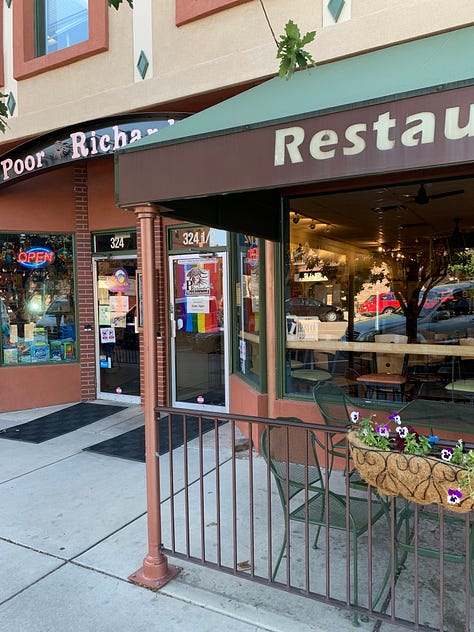

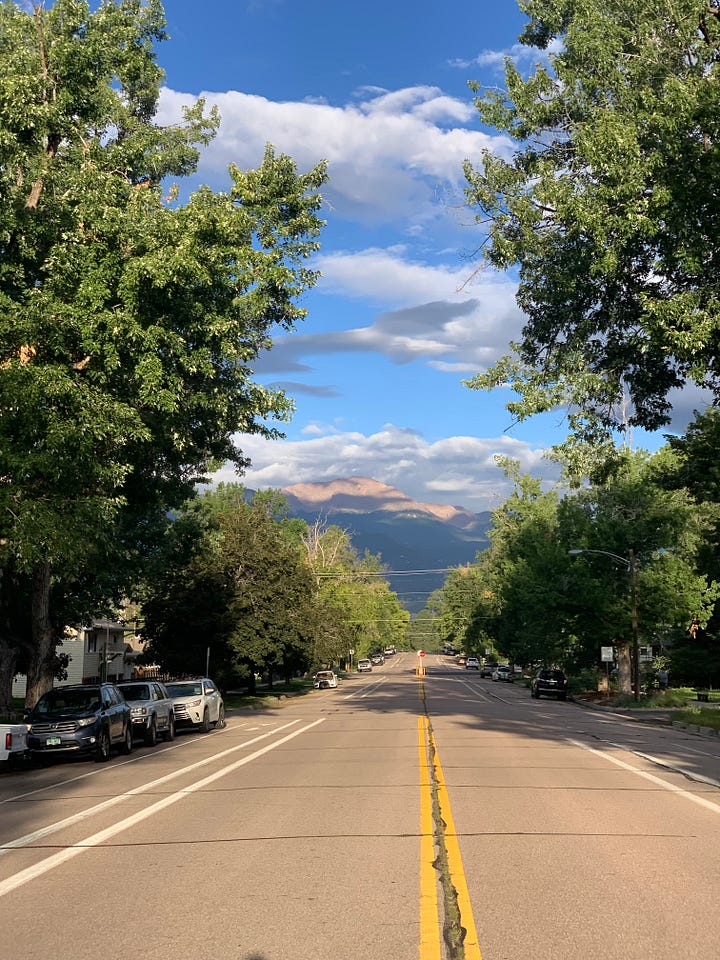
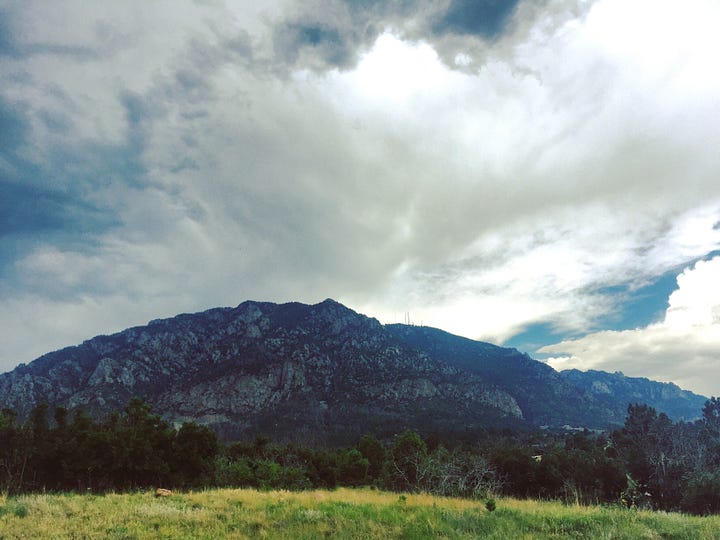
When I step out of Denver International Airport my soul chokes as I see the mountains are a distant, hazy mirage. Much like DIA is removed from Denver, Denver is removed from the Mountains. The sea of yellow fields fold around you like the gray of a prison cell. Sure, this landscape goes infinitely far unlike the physical confines of a cell, but you’re trapped all the same. After 30 minutes driving West you do hit Denver, but the mountains remain a distant vision. The gray and worn asphalt of the I-25 corridor only adds to the monotony. I-25 is a straight-line that cuts across the state, North to South, a manmade representation of the Front Range that compounds the emptiness I feel. Put the car in cruise control and see where you end up in an hour. More of the same. Dead grass and fuzzy mountain views. It’s a mostly repeating stretch of loneliness, all 300 miles of it, the only signs of civilization – suburban sprawl, gas stations, and strip malls.
But hey, Denver is the capital, so surely there’s a unique prairie-to-mountain culture here that defines these first outposts of the West! Not so much. In fact, Denver’s total lack of culture is the only culture I can seem to find. Red Rocks Amphitheatre and John Elway nostalgia (I’m a Jake Plummer guy, myself) seem to be the closest thing to shared, cultural appreciation across groups here. Though perhaps Nikola Jokic is now embedded in that too? (In all sincerity, Go Nuggets!) That, or skiing and snowboarding. But Denver is now infamous for the 8-hour traffic jams it creates along I-70 to visit the ski towns, and it seems like it’s as much the out-of-towners as the locals. (It’s worth noting that the mountains are certainly accessible from Denver and traffic jams aren’t much of an issue in the warmer months. But when you visit and don’t have a car you appreciate the true difference between immediate and moderate outdoor access).
In Denver, the neighborhoods have distinct feels, but none coalesce into a city identity, and in a vacuum, most aren’t memorable. This is Denver’s biggest problem. Despite having individually cool hangouts, and pockets of neighborhood fun, the city as a whole has failed to deliver meaningful distinction and refuses to stand out. Whether this is an issue with such an influx of outsiders (the city has grown by 30% in 20 years – from 554K in 2000 to 715K in 2020), or a city that never had a strong identity to begin with, I don’t know.
The coffee houses, bars, restaurants, and shops along Larimer St. in River North (RiNo) are covered in street art and graffiti, the basic aesthetic for a thriving alternative scene. But when I stepped inside several businesses it felt like a bait-and-switch with the interior feeling sterile and yuppified. The Larimer Lounge, a long time venue in the neighborhood may be an exception, but I have yet to visit.
LoDo wants to be some version of LA with important people filling the floors of exclusive clubs or the booths of loud, dark restaurant bars. Imposing doormen wait outside these replicas but the lines never fully form. When they do fill, it’s a lot of tribal tattoos, tacky gold chains, and tight, tucked-in black tee shirts. Their counterparts have bleached blonde hair, heavy makeup, and ample cleavage. No, these are not iconic hangouts with influential people frequenting them.
Perhaps Cherry Creek best embodies the Denver ideal. A wealthy and ritzy neighborhood known for a higher-end shopping mall. It blends strip mall fast casual dining, new condos, and old multi-million dollar homes seamlessly into a vanilla void of boredom. It’s not trying to be anything other than a place for wealthy people to feel comfortable in a clean, safe, and vapid environment. It’s the most authentically Denver vibe, and it sucks. But at least it’s honest.
Regardless of the neighborhood you’re in, you’ll likely encounter loud, roving packs of self-important bros. You know the ones – lacking any self-awareness as they stomp around in fitted backward caps, polos, and golf shorts. They’re an outsized population here, and in a city that struggles with an identity, a lowest common denominator persona is perfectly suited to take over. And that they have. It can feel like a year-round Santa-con in these parts.
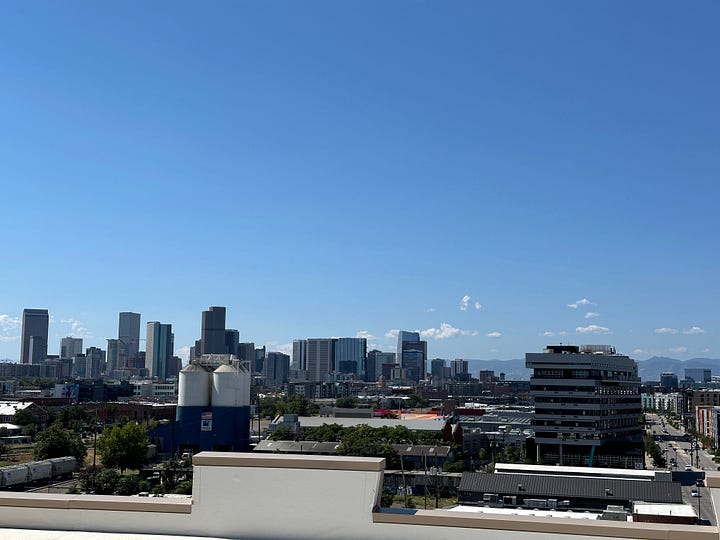

Now, this is a tangent, but hear me out. Music may be the best lens for understanding the lack of culture across the Front Range. A phenomenon exists here that I have yet to encounter anywhere else in the US. Take your run-of-the-mill, unmemorable bar, brewery, or restaurant anywhere in the country. The soundtrack is likely to be predictable – either current hits, classics (whether that be 70’s rock n roll, 80s pop, 90’s hip hop, or something in between), or something inoffensive to fill a void, not impose. Now, go to that same generic hangout in Colorado and you’re almost guaranteed to be pummeled by the worst era of music – late 90s/early 2000s post-grunge and alternative rock, some of which falls into the more specific category of “But Rock.”
You’ll know the sound best as bullshit like Matchbox 20 - Push; 3 Doors Down - Kryptonite; or Train - Drops of Jupiter. Yes, there is an entire state that defaults to this genre as the sound most likely to please patrons. They treat these songs like they’re timeless classics, on the same level as Led Zeppelin’s Immigrant Song, Genesis’ Invisible Touch, or 2Pac’s California Love. You may get tired of those songs, but they’re not going to offend, and more than likely, most people will still be happy to hear them.
Colorado refuses to let this era die out and has collectively put it on a pedestal, highlighting many of the deeper cuts. A pint across the Front Range may well be accompanied by Lifehouse Hanging by a Moment; Fuel Hemorrhage (In My Hands); Tonic If You Could Only See; Gin Blossoms Hey Jealousy; Seven Mary Three Cumbersome; Live Lightning Crashes; and Colorado’s own sin, The Fray How to Save a Life. If your destination is not memorializing this limp rock specifically, they’ve moved onto the next decade of alternative-syrup that has aged poorly, like Twenty One Pilots Stressed Out and Imagine Dragons Believer.
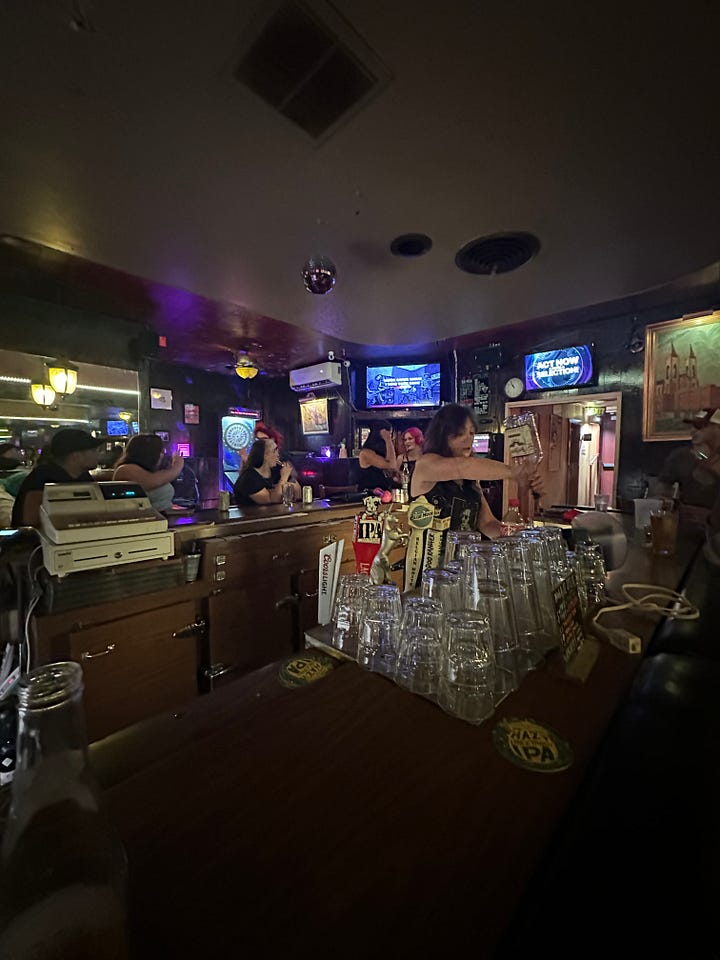



This is not to say there is nothing good in Denver. Capitol Hill and North Capitol Hill are a fun time. And Colfax Avenue, which runs between the two neighborhoods, stays gritty and lively for another few miles east, and will always hold a special place in my heart. This is where the Lion’s Lair, Bluebird Theatre, Ogden Theatre, and Fillmore Auditorium reside. It’s also a stone’s throw from the (now all defunct) 15th Street Tavern, Mercury Café, and London Streets. For decades this hub brought the up-and-comers from every genre of music to Colorado. It was a grimy and real scene too, and I only got to see the all-ages version.
The bars that have withstood the changes of time along this stretch are a bastion for all who need to let loose or simply forget. Last time I was at The Knob Hill Inn it was a mash-up of aging neighborhood regulars and trans twenty-somethings alongside their progressive friends. The mic was passed happily between the young and old, song after song, but they otherwise kept to their own. Up the street at Williams Tavern, I was offered cocaine in the bathroom from someone I hadn’t even met nor seen in the bar prior. He was just an average guy, genuinely looking to share (I declined). And a couple blocks north at The Horseshoe Lounge I’ve shot the shit for hours with friendly bartenders on a quiet night. These were good times with the eclectic crowds that make a place feel like home.
Nearby at the classic hole-in-the-wall El Taco de Mexico, I’ve eaten countless great burritos and tacos over paper plates on a cafeteria tray. I’ve followed that up with bar-hopping South into Speer – I’ve sipped cold ones at Barry’s on Broadway before getting blotto at Don’s Club. These were all good times. But why-oh-why don’t I feel like there’s a sense of community in this cow-town turned tech-city?
In all my travel across this country, whether captured on this Stack or during my many more personal travels, I’ve never experienced quite the vacancy of identity I see back in the Front Range of Colorado. You’ll of course find pockets of good people in these aforementioned hangouts who understand why that’s disconcerting, but the reality is, the self-created void has become the Colorado standard you’ll be reminded of daily.
I’m not naive enough to think I’ve seen it all and I know there’s more to uncover. Good stuff too. But I also know my viewpoint is not simply tainted from growing up there, nor is it incomplete from not experiencing enough. I’ve tried and tried, and what I know to be true is this: the lack of culture that exists in Colorado’s two biggest cities is pervasive and real.
So, Colorado Springs – if you go! Hey, it could happen, and you deserve to know the spots that have kept the youth and long-term residents sane in an overbearing and bleak land. First, downtown (along with the bubble that is Colorado College) really does make up one of the few walkable areas, and to its credit, it’s lovely. Huge trees provide ample shade along cute blocks lined with Tudor, Victorian, and Craftsmen homes, all while Pikes Peak looms in the background. And yes, coffee houses, bars, restaurants, and shops are accessible. And there’s probably a few new, cool places that have cropped up since I left, but I don’t know them. Below is a good jumping off point. If you’re there, ask your friendly bartender what else to hit.
Manitou Springs – It’s right there in the foothills, at the foot of Barr Trail and Pikes Peak, in fact. It’s a walkable, quirky alternative town outside of the Springs, though it really just feels like a neighborhood of the city.
Poor Richards – An absolute gem of a spot – a 3-in-1 bookstore, toy store, and restaurant. Their pizza is solid, the sandwiches are great (their tuna salad sandwich was amazing, but I don’t see it on the menu currently), and, as a kid, their house salad single handedly taught me salad was a good thing. It still rips.
La Baguette – A great French bakery with lovely croissants plus some mean chicken & tuna salad sandwiches, on the aforementioned croissants.
La Casita – A Mexican fast food spot with two locations in the Springs. This place is incredible for hangover breakfast tacos and their lunch & dinner is just as good. Their tortillas are handmade and the best I’ve ever had. Whether that’s a nostalgia thing or something else, I can’t say. But they are unreal. Go out of your way to get them.
Triple Nickel Tavern – Owned by JJ Nobody of Nobody’s fame. Great lil dive that hosts shows and has a lot of sports on TV. A good place to tie on a serious buzz.
Benny’s – This place has been around since I was a kiddo and has good neighborhood sports bar vibes.
The Leechpit – I can almost single-handedly thank owner Adam Leech for ensuring I listened to cool music growing up. It’s a record and thrift store combo that specializes in good rock’n’roll, independent music, and vintage Colorado sports apparel. It is THE spot to hit if you need an escape from the suffocating conservatism of the Springs. “Keep Colorado Springs Lame” is their battle cry and I love it dearly.
The Black Sheep – Formally Industrial Nation (and where my incredible punk band the Gustitutes played twice), it has been around 25+ years (as the Black Sheep it’s more like 15 years) and is the spot that has kept the Springs somewhat relevant with touring musicians.
Vultures – I’ve never been but it’s nice to have a second bar/venue in the city, even if it is literally next door to the Black Sheep.
If you made it this far, I’ll be back to my usual writing in my next post!




So...I grew up in Colorado (Boulder and Denver) and I currently live here. I also have a website/podcast about Denver and the state. While I think what you're sharing are absolutely fair criticisms....you're no longer a resident so the connection that you would feel is difficult to cultivate if you're not having hard conversations with the people who love and care for the city and state on a weekly, etc. basis.
One thing I will say is that cities like Denver (cities with a lot of inbound migration from other parts of the US) have this distinct lack of cohesion. There are all of these people moving here but they don't have an EMOTIONAL connection to the cities that they've landed in. They can enjoy the city like a tourist and bitch about the bad stuff without putting in any work.
I think THIS is what you're noticing. Then-they leave.
For people like me who are civically engaged, have a regular local radio station spot, talk to people about the hard stuff-there is definitely a culture. How would you get a feel for it if you're not truly "here" (no shade-just asking)
You're wrong about the music. Denver is in the top ten for music cities and the breadth of variety and access. Great post.
I visited Denver twice for work this fall and I felt this exact same feeling of strange soullessness, I think you captured perfectly what I couldn't articulate. Denver seems like it should be cool, it has all the elements to be cool, but something just feels missing! I was also struck by how even at rush-hour, the Downtown felt so eerily empty! (I work in downtown Boston and it is absolutely packed and bustling at rush-hour so this was really striking to me.)